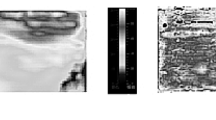Abstract
Fiber-metal laminates (FMLs) consist of three layers of aluminum alloy 2024-T3 and two layers of glass/epoxy prepreg, and it (it means FMLs) is laminated by Al alloy and fiber alternatively. Fatigue crack growth rates in notched fiber-metal laminates under constant amplitude fatigue loading were studied experimentally and numerically and were compared with them in monolithic 2024-T3 Al alloy plates. It is shown that the fatigue life of FMLs is about 17 times longer than monolithic 2024-T3 Al alloy plate; and crack growth rates in FMLs panels remain constant mostly even when the crack is long, unlike in the monolithic 2024-T3 Al alloy plates. The formula to calculate bridge stress profiles of FMLs was derived based on the fracture theory. A program by Matlab was developed to calculate the distribution of bridge stress in FMLs, and then fatigue growth lives were obtained. Finite element models of FMLs were built and meshed finely to analyze the stress distributions. Both results were compared with the experimental results. They agree well with each other.
Similar content being viewed by others
References
Vlot A. Glare history of the development of a new aircraft material. Dordrecht, The Netherlands: Kluwer Academic Publishers, 2001
Wu G C, Yang J M. The Mechanical behavior of GLARE laminates for aircraft structures. J Minerals Metals Mater, 2005, 57: 72–79
Liang Z Q, Xue Y D. Performance and application of GLARE laminates in A380 Airliner. Glass FRP/CM, 2005, 04: 49–51
Liang Z Q, Wu W J. Comparison of GLARE laminate with aluminum alloy and its application. Fiber Glass, 2006, 0: 49–51
Toi R. An empirical crack growth model for fiber/metal laminates. In: Melbourne, Australia: Proceedings of the 18th symposium of the international committee on aeronautical fatigue, 1995. 899–909
Takamatsu T, Shimokawa T, Matsumura T, et al. Evaluation of fatigue crack growth behaviour of GLARE3 fiber/metal laminates using compliance method. Eng Fracture Mech, 2003, 70: 2603–2616
Marissen R. Fatigue Crack Growth in ARALL, A Hybrid Aluminium-Aramid Composite Material, Crack Growth Mechanisms and Quantitative Predictions of the Crack Growth Rate. Dissertation for the Doctoral Degree. Delft: Delft University of Technology, 1988
Guo Y J, Wu X R. A theoretical model for predicting fatigue crack growth rates in fiber-reinforced metal laminates. Fatigue Fracture Eng Mater Struct, 1998, 21: 1133–1145
Alderliesten R C, Homan J J. Fatigue and damage tolerance issues of Glare in aircraft structures. Int J Fatigue, 2006, 28: 1116–1123
Chang P Y, Yang J M. Modeling of fatigue crack growth in notched fiber metal laminates. Int J Fatigue, 2008, 30: 2165–2174
Cox B N. Life prediction for Bridged Fatigue Cracks, Life Prediction Methodology for Titanium Matrix Composites, ASTM STP 1253. Johnson W S, Larsen J M, Cox B N, eds. ASTM, 1996. 552–572
Shim D J, Alderliesten R C, Spearing S M. Fatigue crack growth prediction in GLARE hybrid laminates. Composite Sci Tech, 2003, 63: 1759–1767
Lapczyk I, Hurtado J A. Progressive damage modeling in fiber-reinforced materials. Composites-Part A, 2007, 38: 2333–2341
Standard Test Method for Tensile Properties of Polymer Matrix Composite Materials. ASTM D3039
Standard Test Method for Tension-Tension Fatigue of Polymer Matrix Composite Materials. ASTM D3479/D3479M
Alderliesten R C. Development of an empirical fatigue crack growth prediction method for the Fibre Metal Laminate Glare. Dissertation for the Master Degree. Delft: Faculty of Aerospace Engineering, Delft University of Technology, 1999
Marcela V. Cid Alfaro, Akke S J. Suiker. Analysis of fracture and delamination in laminates using 3D numerical modeling. Eng Fracture Mech, 2009, 76: 761–780
Wang R G, Zhang L. Numerical analysis of delamination buckling and growth in slender laminates composite using cohesive element method. Comput Mater Sci, 2010, 50: 20–31
Author information
Authors and Affiliations
Corresponding author
Rights and permissions
About this article
Cite this article
Ma, Y., Xia, Z. & Xiong, X. Fatigue crack growth in fiber-metal laminates. Sci. China Phys. Mech. Astron. 57, 83–89 (2014). https://doi.org/10.1007/s11433-013-5336-6
Received:
Accepted:
Published:
Issue Date:
DOI: https://doi.org/10.1007/s11433-013-5336-6




